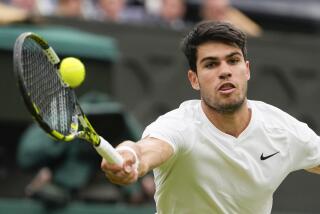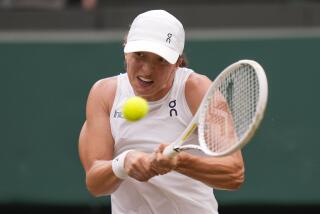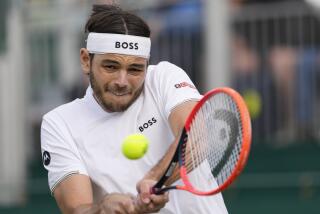WHERE THE GAMES BEGAN : CENTRE OF A UNIVERSE : A Museum Celebrates Birth of Tournament Tennis at Wimbledon
- Share via
WIMBLEDON, England — Centre Court and the 12,433 seats surrounding it at this birthplace of tournament tennis play sit here waiting.
Crows fly overhead, cawing raucously. There are no other sounds.
The mind flashes back. The crowd roars as Pat Cash leaps into the stands and climbs up to his father after the Aussie has beaten Ivan Lendl for the singles crown last July.
Martina Navratilova circles the court, holding high the silver tray that came with her eighth win, a very special victory over Steffi Graf that ties the all-time women’s singles record held by Helen Wills Moody.
Back to the present. There is only the green grass now in Centre Court. No net. No players. No one in the stands. Utter silence, except for the crows.
It is still and empty here at Wimbledon’s Centre Court all year long, except for two glorious weeks in June.
Centre Court is reserved solely for the championship matches. No other tennis is played here the remaining 50 weeks of the year.
“A lot of people want to see where it happens,” said Sarah McCance, 25, of the Wimbledon Lawn Tennis Museum staff. A door leads from the museum to a specially constructed viewing platform.
And there you are at the cathedral of tennis--Wimbledon’s Centre Court.
The All England Lawn Tennis and Croquet Club at Wimbledon, a half hour’s ride on the underground from Hyde Park in the heart of London, is a shrine to the game of tennis.
Here, the Wimbledon Lawn Tennis Museum’s new exhibition galleries, opened during the 1985 tournament, house the archives of the popular game--modern lawn tennis--that was derived from ancient court tennis and introduced at a garden party in Wales in the 1870s.
The museum with its marvelous collection of tennis memorabilia is open year-round.
Major Walter Wingfield, the originator of the modern-day game, called it sphairistike-- Greek for ballgame. Players shortened it to sticky. Wingfield tried but failed to get a patent for it. And the name sticky didn’t stick. Instead, people called it tennis.
A sphairistike kit came in a croquet-like box and included instructions, four rackets, balls, netting, poles and pegs. Wingfield’s game was played on a court shaped like an hour-glass.
The first lawn tennis club wasn’t at Wimbledon. It was at Leamington Spa in England, established in 1872. The club at Wimbledon came along five years later in 1877, the same year of the first Wimbledon championship matches.
Spencer Gore was the first Wimbledon men’s singles champion. There were 22 players entered. A crowd of 200 paid one shilling each. Gore defeated William C. Marshall for the title. That first Wimbledon trophy won by Gore is in the Wimbledon museum.
In 1878, Patrick Hadow, a Ceylon tea planter, defeated Gore for the crown. The winner the following two years was a Yorkshire preacher, the Rev. J. T. Hartley.
Runner-up for the title in 1879 was Vere Thomas St. Leger Goold. He was arrested for murder in 1907, was found guilty and spent the rest of his life as a prisoner on Devil’s Island.
Twins and brothers dominated Wimbledon play all through the 1880s and 1890s. William and Ernest Renshaw won the men’s doubles seven times in the 1880s. They called it the fore-handed championships in those days.
And William Renshaw holds the all-time record for winning seven Wimbledon mens’ singles titles, 1881-1886 and 1889. His twin won the singles in 1888. Trophies and rackets of the Renshaw twins are in the museum as well as photographs of them at play.
Next came the Baddeley twins, Wilfred and Herbert. Wilfred won the singles title three times in the 1890s and the twins were doubles champions four times in the 1890s. You can find out all about them in the museum.
From the twins it went to brothers, Reggie and Laurie Doherty, who won the doubles from 1897 through 1901 and again from 1903 through 1905. Reggie won the singles title from 1897 through 1900, and Laurie won it from 1902 through 1906.
Wrought iron gates at the main entrance to the All England Lawn Tennis and Croquet Club are called the Doherty Gates in honor of the brothers, both of whom died in their 30s.
Costumes worn down through the years by the players adorn mannequins. Nineteenth Century women wore dresses that nearly touched the ground and covered corsets, petticoats and long drawers.
Maud Watson won the first womens’ singles title in 1884. British women won every year until 1905, when American May Sutton broke the English rule. British men won every year until Australian Norman Brookes came out on top in 1907. Since then, only two British players have won the men’s singles again, Arthur Gore and Fred Perry.
It’s all here, documented, year by year with accompanying photographs and artifacts from the beginning. A tape plays a BBC montage of sound from tournament play since 1922. In the museum’s theater is a continuous film of great Wimbledon matches.
Tennis was the rage in England in the 1880s and 1890s and the museum has numerous collectibles of that era--ceramic figures of tennis players, cups and teaspoons with tennis racket handles, ink wells in the shape of tennis balls.
W. H. Tuck originals, popular turn-of-the-century paintings of cats playing tennis, and Cecil Aldin’s equally popular early 1900s original paintings of pigs, ducks and foxes playing the game are on exhibit.
By the turn of the century, there were at least 500 small workshops in England hand-crafting tennis rackets. One of those shops has been reproduced, and examples of the way tennis balls and rackets have been changing through the years are on exhibit.
Trophies presented to winners in Centre Court are on display--the silver tray awarded the 1864 women’s singles winner, the 1887 men’s singles silver cup, the men’s doubles 1884 silver cup, and the women’s doubles 1949 silver cup.
Behind glass are the autographed shoes worn by John McEnroe and Boris Becker when they won here, the racket Jimmy Connors used when he won, and the headband and wristband worn by Pat Cash last July.
Wimbledon the rest of the year is a private club with only 375 members. There are 17 other grass courts and 11 hard courts on the club’s 42-acre grounds.
Among the hundreds of photographs on display are those showing Wimbledon at war from 1940 until 1945. Norah Cleather, the acting secretary, was left in charge. Her duties were to weed the courts and care for the livestock grazing there.
The All England Lawn Tennis and Croquet Club was bombed 16 times by the Germans, one of the hits destroying 1,200 seats in Centre Court.
Royalty occupied the Royal Box from early on at the championship matches. Photos from the 1895 competition show Stephanie, crown princess of Austria, in the Royal Box. King George V officiated at the new Wimbledon facility in 1922. The Duke of York competed in 1926. There’s a bronze statue of King Edward VII with tennis racket in hand.
“The last time Queen Elizabeth was here was in 1977 for the 100th anniversary of the first Wimbledon championship matches,” said Sarah McCance of the museum staff. “The Queen presented the trophy to the winner of the ladies singles. I don’t think the Queen likes tennis. If she did, she would show up more often.”
More to Read
Go beyond the scoreboard
Get the latest on L.A.'s teams in the daily Sports Report newsletter.
You may occasionally receive promotional content from the Los Angeles Times.










